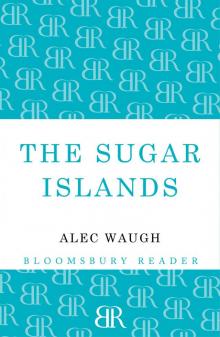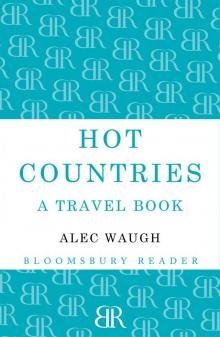- Home
- Alec Waugh
Where the Clocks Chime Twice Page 2
Where the Clocks Chime Twice Read online
Page 2
All day the sun had shone. The hotel time-table announced five to seven as the cocktail hour, but most of the guests lingered on the beach gossiping, playing bridge and Canasta, reading and taking dips till dusk fell. Everyone was exhausted by sun and exercise, by long hours in the open air. By nine o’clock good nights were being said. By ten o’clock the lights in the lounge were out.
To the same extent that St. Croix is different from St. Thomas, St. John is different from St. Croix. I left St. Croix by the morning plane with a fellow guest who was returning to New York. Though I had seen from the hills above Christiansted the outline of St. John on the horizon, my fellow traveller was in New York before I had reached Trunk Bay. There are only two boat-trips daily from St. Thomas, and the morning boat had already gone when I reached the airport.
The caprice of geography as of history has played its part in St. John’s fortunes. Although separated from St. Thomas by only a few miles of water, it is so protected by islands that when you make the half-hour journey across to it by launch you do not feel you are in the open sea but in a large inland lake. Though in actual size it is only a little smaller, twenty square miles against twenty-eight, you have the sense, after making that short trip, of being upon another planet. Too mountainous to be suitable for agriculture or pasturage, cut off by that narrow channel from the commerce of Charlotte Amalie, St. John supported under 2,500 even in the peak period of the eighteenth century, when St. Croix’s population was 28,000. When sugar slumped, as the result of emancipation and the discovery of beet-sugar, St. John folded up. Only 800 people are living there to-day.
It is as empty as any place could be. Not even in the interior of Haiti have the relics of former grandeur been obliterated more completely. The jungle has reclaimed it all—the canefields, the carriage drives, the slave quarters, the plantation houses. The old walls are buried deep in scrub and creeper. There are no roads now, only trails. There are no motor-cars. You travel on foot or horseback; or by motor-launch around the coast from bay to bay. You lead a completely rural life, getting up at sunrise, breakfasting at seven, going to bed almost directly after dinner; an open-air life of sailing, swimming, fishing. Everything is very primitive. Each house is responsible for its own supply of water. Rooms are lamp-lit. There is no town, there are no shops, no telephones. There are no cocktail parties and no newspapers. There is one quite substantial resort, at Caneel Bay. There is a guest-house or two; four or five private homes, and that is all.
Myself, I was bound for the Bulon Guest-house. Trunk Bay, which it overlooks, is a couple of headlands beyond Caneel, where the launch deposits you. A minute launch awaits you at the jetty. Before you have been in it five minutes you have very markedly the sense of being in the open sea. You no longer have the protection of the islands. The launch dips and plunges and vibrates, splashing water over you. On your right the hills rise, covered to their summits with trees and scrub. On one of the lower promontories is an abandoned windmill. Trunk Bay is a beach and nothing more. There is no projecting jetty. You change from the launch into a rowing-boat, and then wade ashore. The Bulon Guest-house is half-way up the hill. It has a wide, deck-like verandah facing west and north. It was noticeably cooler than Charlotte Amalie or Christiansted. The verandah was lit by hurricane lamps, not electric light.
There were four or five guests on the verandah. It was shortly after six. Most of them had a glass beside them. “Do I ring for a drink?” I asked. There was a laugh at that. They had the honour system, they explained. You could buy your own bottle or you could mix your own drinks by the glass. You signed for them in a book. Limes and ice and sugar, but not soda, were on the house. Beer and Coca-Cola were in the icebox.
It was Sunday, and supper took the place of dinner, a cold meal served on the verandah. Conversation turned on the next day’s activities. A party was going round the island in the launch. The trip was to start at half-past seven. I had known many picnics scheduled to start at least an hour before they do. I was more than surprised next morning, before sunrise, to hear footsteps below my room. As I went down to the beach to swim shortly after six, I met one of the guests coming up from the cottages fully dressed. I was the last arrival at the breakfast-table at five to seven. By a quarter-past seven I was on the verandah, my manuscript before me.
Rarely have I felt myself more surrounded with peace and beauty than I did as I sat there writing on that high deck-like verandah with a white, palm-lined beach below, with the mountains climbing green behind, with pelicans gliding above, then diving suddenly into the shallow water, with sloops from Tortola drifting across the middle distance, with the whole horizon littered with the shapes of islands, with the water every shade of blue, and with the trade wind cooling the sun’s heat. St. John was certainly as different from St. Croix as St. Croix had been from St. Thomas.
Those three first days illustrate not inaccurately the differences between the islands, though as regards St. Thomas and St. Croix those first days are less typical than symptomatic. It was on a Saturday that I reached St. Thomas, and normally Charlotte Amalie is not all that gay. It was on a Sunday that I reached St. Croix, and St. Croix is not normally that quiet. On the contrary, it has a very active social life. There are probably more cocktail parties in St. Croix in a week than there are in St. Thomas in a month, but they are a different kind of party.
St. Croix was originally an exclusively agricultural community. Its early history is involved; at one period or another it was owned by practically every European power, including the Knights of Malta. Under the French it failed for a time to prosper. For a few years it was practically uninhabited, and the French in 1733 were glad to sell it to the Danes to prevent its falling into British hands. The Danes invited planters from other islands to undertake its cultivation, and under Danish rule, with Denmark a neutral throughout the succession of eighteenth-century wars, it prospered so rapidly that within twenty years every acre of the island was under cultivation; it supported a population of thirty thousand. To-day that population has been halved. The sugar industry, as bankrupt in St. Croix as in the British islands, is subsidised, as a form of poor relief. All the cane is ground at a single central mill under Government control. Only about half the island is under cultivation. The sugar is not particularly good. There is so much unsold Cruzan rum under Federal seal that the manufacture of it has been abandoned. None of the continentals who have settled in St. Croix during the last four years are planters to more than an amateur extent, though some of them run small five- to ten-acre estates as a hobby. They have come down to paint, to design furniture, to write, to sail. But though the patrician planter aristocracy exists no longer, the traditions of an agricultural community have been maintained. Agriculturists are always vaguely contemptuous of townsfolk, and Cruzan society is centred in the country. It is a residential society, existing independently of tourists. It does not depend on tourists for its amusement or support. It has its homes, its parties, its private beaches, where groups of friends take picnics out on Sunday and play volleyball afterwards on the sand.
On the west coast of the island, fifteen or so miles from Christiansted, is Fredericksted. It is an even quieter town than Christiansted, and it suffered heavily during a workers’ riot in the 1870s; but it has a definite life of its own. Just as one part of the island treats Christiansted, so does another section treat Fredericksted as its market town. Eric Hatch has organised a Jonkey Club, which holds donkey races on the baseball-field. The five-days’ visitor to the Cay or to the Buccaneer who did not arrive with letters of introduction to any of the residents might imagine that not very much was happening in St. Croix. He would have an enjoyable and healthy life, bathing, sailing, fishing, taking motor trips, but he would interpret the absence of restaurants and bars and night-clubs to mean a lack of social life. He would be mistaken. A great deal is going on, only it is going on in private houses; it is a life built up by the residents among themselves, carrying on the original traditions of the island.
From the earliest days there has been that essential difference between the islands—St. Thomas is commercial, St. Croix agricultural; St. Thomas is urban, St. Croix is rural. The soil of St. Thomas is as poor as that of St. Croix is rich. The sole industry in St. Thomas in all its history was the manufacture of bay rum, and the bay leaf was grown upon St. John. Most of its food has always had to be imported. Only in its north-west corner, and to a small extent, have the descendants of French colonists been able to exploit their hereditary capacity to wring sustenance from the most barren soil.
St. Thomas is a port. That is its history. That is its significance. Not only has it a fine natural harbour but it is the first landfall for ships sailing West from Europe. Denmark’s neutrality during the eighteenth century made it the perfect rendezvous for the ships of warring nations. For a time it was a hide-out for the buccaneers, and two of its forts are known respectively as Blackbeard’s and Bluebeard’s Castle, though there is little historical evidence to support the legend that it was the home of the fierce Edward Teach of Bristol, who tucked the ends of his great black beard behind his ears and justified his habit of suddenly snuffing the candles over dinner and firing his pistols at his guests with the retort, “If I don’t kill one of you now and then, you’ll forget who I am.”
Perhaps the legend grew because there was so little other scope for legend. The people is happy that has no history, and St. Thomas has been a happy island. While the others—St. Lucia, Grenada, Haiti, Martinique—were the scenes of war and massacre, St. Thomas followed its pacific way, sheltering, succouring, and gathering the fruits of its immunity; becoming, as soon as the brief Napoleonic interregnum, when the Union Jack flew from Christian’s Fort, was over, once again an open port and the exchange centre of Caribbean trade. Only by slow stages did it lose that fortunate position, as the other islands—in particular Puerto Rico —came gradually to realise that through the power of steam-driven vessels it was not only possible but profitable to deal direct with Europe; one by one the main steamship lines began to move their headquarters—the R.M.S.P. to Barbados, the C.G.T. to Martinique. In time, so far as Denmark was concerned, an asset became a liability. But the slump came slowly. For Thomasians themselves there was always a modicum of prosperity.
Charlotte Amalie is St. Thomas. A fact which might sound a condemnation. It is a safe rule in the tropics to get out of town as soon as possible. Papeete, Bangkok, Fort-de-France, in essence no matter how superficially dissimilar, are all the same—hot and noisy, with honking car-horns, the air stale and fetid, juke-boxes playing, a restless vibration in the atmosphere; you feel that something is going to happen, but it never does; your head aches, you sleep too little and you drink too much. A much-travelled friend wrote to me from New York, “St. Thomas doesn’t sound like the ideal place for you to re-establish your communication and respect for islands. From all I’ve heard, St. Croix will be more like it. I’ve always imagined that St. Thomas would have a pathetic honkey-tonk atmosphere about it, which is bearable when it’s a place like Marseilles or Christobal that has a water-front culture to go with it all, but I prefer my islands straight and hot, without blues notes. …”
And she was right: dead right, or rather she would have been right nine times in ten. St. Thomas is an exception. What Juan-lesPins is to the Riviera, Charlotte Amalie is to the Caribbean. It has admittedly a restless, gaudy, night-club atmosphere; and it has, in addition, the exacerbation of its divorce mill. Not so many people come down ‘to take the cure’ as is generally supposed, four hundred a year is a rough average. But each of those appeals involves a six weeks’ visit. Each appeal involves a personal problem. Each applicant is in her own particular way worried, lonely, at a loose end, uncertain of her immediate future; not sure, now that it has come to the final point, whether she has done the wise thing, after all. The presence of those four hundred plaintiffs is a highly flavoured ingredient in the general atmosphere. Yes, Charlotte Amalie is a restless place, just as Juan is, but it has also, just as Juan has, an air of elegance.
John Vandercook in Caribbee Cruise, the outcome of a trip in the late ‘30s, described the shops in Charlotte Amalie as being ‘more useful than alluring’. That would not be true to-day. The old wharves running down from the main street to the sea, that mouldered and crumbled during the depression, have been converted into art galleries and stores by experts in the art of showmanship. Most shops have bars attached to them. You sit at Elverhoj’s over a cool Rum Collins and look down a large, high-arched, stonebuilt warehouse supported by red pillars, its walls painted light pink and green. At the far end of the room there is a constant movement of bright fabrics, wide-sashed belts, wide-swinging skirts, blouses low-cut over sun-tanned shoulders. I can think of no more acute inducement to extravagance.
Everywhere in Charlotte Amalie the eye is caressed and charmed. Built as it is over and between three rounded hills that run as spurs into a harbour studded with islands, it is the ideal setting for a town. From the verandah of every villa you get a new and charming view. Years ago Sir Frederick Treves described it as the most picturesque town in the whole sweep of the Windward Islands, and that was before modern skill had developed its possibilities; before the two forts, Blackbeard’s and Bluebeard’s Castles, had been made hotels; before Ira Smith had converted a ruined street of steps into a guest-house studio and bar.
This, indeed, is how I should sum it up. It is a question of the mood you are in. St. Croix, St. Thomas, St. John, they have each something very special to give you, provided you are in the right mood for it.
They say that the British colonies are more British than Britain is. In a way they are. An American would learn as much about England by dividing three months between Grenada, Barbados, and St. Lucia as he would by spending a year in London. He would see a microcosm of English society. He would observe its formalities, the dressing in the evening, the punctuality, the parade atmosphere of dinner. The leaving of cards with the left-hand top corner of the pasteboard turned over has now been in the main abandoned, as it has in London. But in Siam in 1926 I should have committed a grave solecism if I had not hired a car and driven out four miles into the bush, at quite considerable cost when I was short of money, to leave a card upon my host of the previous evening whom I knew I should be seeing at the club three hours later.
That is over now. But there remains the concentration upon clubs, the ritual of Government House, the signing of the book on arrival and departure, the signing of it after you have been entertained there. The sun never sets on Government House.’ So ran Noel Coward’s satire, and though in a large island like Jamaica or Ceylon a foreign visitor might not be aware of the extent to which the social life of the colony takes its tone and colour from the personality of the King’s representative, in Grenada or St. Lucia he could not fail to realise how every activity is concentrated upon Government House, how integrated is the social life and how he himself must, if he is to have any fun at all, become a part of it. English colonial life is a direct corollary to the old pattern of feudal life, with the various concentric circles radiating outward from the court to the far circumference of the artisan and peasant.
In the U.S. Virgin Islands there is no such concentration. It may be that it is an impertinence for an Englishman to dogmatise about a country that he can necessarily only know at second-hand, but, just as I learnt a lot about France from a two months’ stay in Martinique—the extreme conventionality of French family life, the almost purdah-like imprisonment of its womenfolk, coupled with the freedom of its menfolk to mix without embarrassment with the native population—so by spending five weeks in the Virgin Islands I feel that I am now better able to understand certain aspects of American life and history.
The continentals, as I see it, came to the Virgin Islands in the same spirit that their ancestors came to the United States. The nineteenth-century emigrants escaping from conditions that had grown irksome, i
n search of a new and fuller way of life, arriving as strangers, looked about them for friends who would think as they did, with whom they could share their tastes, their interests, their ambitions; with whom they could form a group, self-contained and self-sufficient, whose strength and preservation would depend upon the existence of other groups whose rights would be maintained by a central authority acknowledging not only the privileges but the obligations of each separate group. The direction of the individual emigrant, that is to say, was a search first for the group, then through the group towards a central authority. While English life based on its feudal system represents a growth outwards from a centre, American life represents a growth inwards towards a centre. I think history would show that this principle was at work in the whole ‘manifest destiny’ operation of the nineteenth century, and I think it is in operation in the boom that has struck the Virgin Islands in the last few years.
There is no centralised social life here in the sense that there is in a British island. There is instead a succession of different groups. Tourists to St. Thomas and St. Croix need not arrive with letters of introduction to enjoy themselves. They do not feel out of things if they do not belong to clubs. In the strict sense of the word, there are no clubs; though The Constant at St. Thomas tries through its Thursday buffet suppers and Sunday beach parties to provide for resident continentals a common meeting ground for one another, a recent anti-discrimination law has practically, though, I suspect, unconstitutionally, made the forming of a private club illegal. The tourist who has letters of introduction will have a better time, but there is no need for him to have them. The majority of hotels are run on the American plan; it is a system that has some disadvantages, but it has the advantage of making each hotel a kind of club, and indeed each hotel in St. Thomas has its own particular cachet, its own clientele, so that it is wise for the tourist to find out in advance the hotel that suits his tastes.

 A Spy in the Family
A Spy in the Family Love in these Days
Love in these Days The Balliols
The Balliols Kept
Kept Fuel for the Flame
Fuel for the Flame Wheels within Wheels
Wheels within Wheels The Sugar Islands
The Sugar Islands No Truce with Time
No Truce with Time My Place in the Bazaar
My Place in the Bazaar Thirteen Such Years
Thirteen Such Years The Loom of Youth
The Loom of Youth A Year to Remember
A Year to Remember A Family of Islands
A Family of Islands Brief Encounter
Brief Encounter Guy Renton
Guy Renton So Lovers Dream
So Lovers Dream His Second War
His Second War My Brother Evelyn & Other Profiles
My Brother Evelyn & Other Profiles The Mule on the Minaret
The Mule on the Minaret Sir!' She Said
Sir!' She Said Nor Many Waters
Nor Many Waters The Fatal Gift
The Fatal Gift Where the Clocks Chime Twice
Where the Clocks Chime Twice Hot Countries
Hot Countries Unclouded Summer
Unclouded Summer Island in the Sun
Island in the Sun